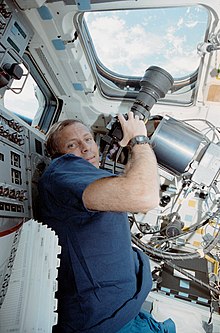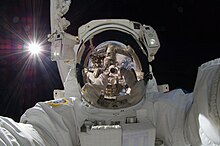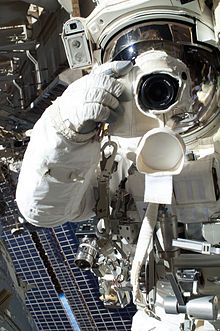List of NASA cameras on spacecraft
This article relies largely or entirely on a single source. (October 2015) |



NASA has operated several cameras on spacecraft over the course of its history.
- Apollo TV camera
- Hasselblad "Electric Camera" (modified 500 EL) with 70 mm film
- Maurer Data Acquisition Camera (DAC) with 16 mm film
- Nikon F with 35 mm film
- Mapping (Metric) Camera (7.6 cm focal length) with 127 mm film, on Apollo 15, 16, and 17 (see Sherman Fairchild#Lunar photography)[1]
- Stellar Camera (7.6 cm focal length) with 35 mm film, on Apollo 15, 16, and 17
- Panoramic Camera (61 cm focal length) with 127 mm film, on Apollo 15, 16, and 17
Personal camera equipment:[2]
- Television camera
- 16 mm film video camera
- 35 mm film camera
- 70 mm film camera
Space Shuttle program
[edit]- Space Shuttle booster cameras.[3]
- Space Shuttle External Tank camera
- Columbia
- Shuttle Infrared Leeside Temperature Sensing experiment
- Nikon NASA F4
Lunar missions
[edit]- Pioneer program, 1958–1960
- Lunar Orbiter program, Lunar Orbiter 1–5, 1966–1967
The camera used two lenses to simultaneously expose a wide-angle and a high-resolution image on the same film. The wide-angle, medium resolution mode used an 80 mm F 2.8 Xenotar lens manufactured by Schneider Kreuznach, Germany. The high-resolution mode used a 610 mm F 5.6 Panoramic lens manufactured by the Pacific Optical Company. The film was developed on-orbit, and then scanned by a photomultiplier for transmission to Earth.
- Clementine, 1994
- Lunar Precursor Robotic Program, 2009
- Lunar Reconnaissance Orbiter
- Lunar Crater Observation and Sensing Satellite
- One visible, two near infrared, and two mid-infrared cameras
- Gravity Recovery and Interior Laboratory, 2011
Other missions
[edit]See also
[edit]References
[edit]- ^ Apollo 15 Preliminary Science Report, NASA SP-289, 1972
- ^ EP-107 Skylab: A Guidebook, Chapter 5
- ^ Madrigal, Alexis (14 July 2011). "NASA's Rocket Booster Cam Video". The Atlantic. Retrieved 3 January 2013.


 French
French Deutsch
Deutsch